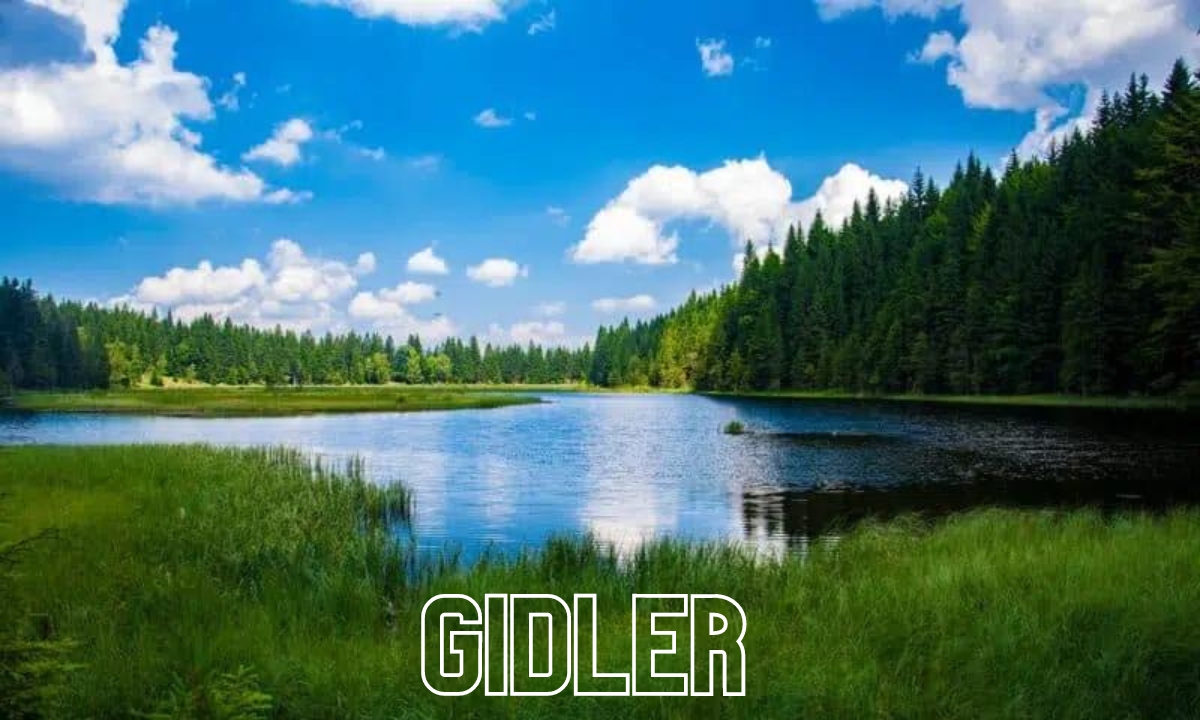General
Gidlers: Guardians of Aquatic Realms – Unveiling the Mysteries of Nature’s Hidden Gems

Introduction to Gidlers
Welcome to the enchanting world of gidlers, where mysterious creatures lurk beneath the shimmering waters of lakes and rivers. Brace yourself for an adventure as we dive deep into the realm of these unusual beings! With their plump, tadpole-like bodies, four stubby legs, and a tail that doubles as a fifth limb, gidlers are truly one-of-a-kind. Prepare to be captivated by their vibrant colors ranging from greenish-brown to bright orange. So grab your snorkel mask and get ready to explore the fascinating world of gidlers – nature’s hidden gems!
Physical Characteristics and Habitat
Gidlers are fascinating creatures with a unique set of physical characteristics that allow them to thrive in their aquatic habitats. These plump, tadpole-like beings have four stubby legs and a tail that acts as a fifth limb, enabling them to maneuver through the water with ease. Their bodies come in various colors, ranging from greenish-brown to bright orange, which helps them blend seamlessly into their surroundings.
These unusual creatures can be found dwelling near the bottom of lakes and rivers, where they feel most at home. They prefer calm waters with plenty of vegetation for cover and protection. Gidlers are highly adaptable and can tolerate different water conditions, whether it be freshwater or slightly brackish.
Their habitat plays a crucial role in shaping their physical features. The presence of algae provides gidlers with a consistent food source while also offering additional camouflage against predators. In addition to algae, gidlers feed on small fish and invertebrates that inhabit the same environment.
With their unique body structure and coloration, gidlers have become well-suited for life beneath the water’s surface. Their plump bodies provide buoyancy while their leg-like appendages aid in navigation across uneven terrain on the lake or riverbeds.
Inhabiting these watery realms presents its own challenges and opportunities for survival. Despite facing threats from larger predators such as birds or larger fish species, gidlers have evolved several adaptations that help protect them from harm.
Overall,gidler populations play an essential role within aquatic ecosystems by controlling algal growth through herbivory consumption.
The conservation efforts should prioritize protecting water qualityand preserving natural habitats.
Gidler any knowledge gaps exist surroundinggidler behavior,reproduction,and ecological significance.
Therefore,further research is neededto better understandthese captivatingcreaturesand ensuretheir long-term survivalin our lakesand rivers
Diet and Feeding Habits
Gidlers have quite the diverse menu when it comes to their diet. These fascinating creatures are opportunistic feeders, meaning they will eat whatever food source is available to them at any given time. Their primary sources of sustenance include algae, small fish, and invertebrates.
With their plump bodies and stubby legs, gidlers are well-equipped for bottom-dwelling. They use their tails as a fifth limb to maneuver through aquatic vegetation and search for food. It’s quite a sight to see these little creatures scurrying along the riverbed or lake floor!
When it comes to feeding on algae, gidlers have a unique adaptation that sets them apart from other aquatic animals. They possess specialized mouthparts that allow them to scrape algae off rocks or other submerged surfaces with ease. This adaptation enables them to feast on abundant algal blooms that occur throughout the year.
In addition to algae, gidlers also prey on small fish and invertebrates. With lightning-fast reflexes, they can snatch up unsuspecting prey with precision. These little predators may be small in size but don’t underestimate their hunting skills!
The feeding habits of gidlers not only contribute to their survival but also play an essential role in maintaining the balance of ecosystems they inhabit. As they consume excess algae, they help prevent overgrowth which can lead to oxygen depletion and harm other aquatic organisms.
Gidlers are versatile omnivores who take advantage of various food sources within their environment. Their adaptability ensures that they thrive in lakes and rivers worldwide! So next time you’re near a body of water, keep an eye out for these quirky creatures as they go about satisfying their appetites!
Reproduction and Life Cycle
Gidlers have a fascinating reproductive process that starts with courtship rituals. When it’s time to mate, the male gidler will perform an intricate dance, using its tail to create mesmerizing patterns in the water. This display not only attracts females but also showcases the male’s fitness and agility.
Once a female is enticed by the male’s performance, they engage in a unique form of internal fertilization. The female gidler has specialized organs that allow her to store sperm for extended periods. This adaptation ensures that she can fertilize her eggs at precisely the right moment when conditions are optimal for their survival.
After fertilization occurs, the female lays numerous small gelatinous capsules containing developing embryos. These capsules adhere to underwater surfaces such as rocks or plants and provide protection against predators until hatching takes place.
The gestation period varies depending on environmental factors such as temperature and food availability. Typically, it ranges from several weeks to a few months. Once hatched, juvenile gidlers resemble miniature versions of adults but lack full coloration.
During their life cycle, gidlers undergo metamorphosis similar to amphibians like frogs or salamanders. As they grow older, they develop limbs from their stubby appendages and lose their tadpole-like appearance.
This transformation marks a significant milestone in their development as they transition into adulthood and gain increased mobility both on land and in water.
Stay tuned for our next section where we’ll delve into some unique adaptations of these intriguing creatures!
Unique Adaptations of Gidlers
Gidlers, with their unusual appearance and lifestyle, have developed some fascinating adaptations that help them thrive in their aquatic habitats. These unique features set them apart from other creatures in the water.
One remarkable adaptation of gidlers is their tail, which acts as a fifth limb. This versatile appendage allows them to maneuver through the water with ease, propelling themselves forward or changing direction swiftly. It also aids in capturing prey and escaping predators.
Another interesting adaptation is the plump, tadpole-like body of gidlers. This shape helps them maintain buoyancy in the water and enables efficient movement without expending too much energy. Their streamlined physique reduces drag and allows for swift maneuvers when hunting or avoiding danger.
Gidlers also possess specialized sensory organs that allow them to detect vibrations in the water. These sensors help them locate prey or sense approaching predators even in low visibility conditions. Additionally, they have excellent camouflage abilities due to their color variations, blending seamlessly with their surroundings.
Furthermore, gidlers have evolved a unique respiratory system that enables them to extract oxygen directly from the water using gills located behind their heads. This adaptation allows for efficient respiration while submerged and ensures an adequate oxygen supply for survival.
These extraordinary adaptations make gidlers perfectly suited for life underwater. They are well-equipped to navigate through various challenges posed by their environment and fulfill their role as important members of aquatic ecosystems.
Threats and Conservation Efforts
Human activities pose a significant threat to the gidler population. Pollution from agricultural runoff, industrial waste, and sewage can contaminate their habitats, leading to a decline in their numbers. The excessive use of pesticides and herbicides also affects gidlers indirectly by reducing their food sources.
Additionally, habitat destruction is a major concern. Deforestation near rivers and lakes destroys the vegetation that gidlers rely on for shelter and breeding grounds. Urbanization often leads to the construction of dams or reservoirs, altering natural water flows and disrupting gidler populations.
Conservation efforts are crucial to protect these unique creatures. Several organizations work towards preserving gidler habitats through initiatives like wetland restoration projects. These projects aim to improve water quality while creating suitable environments for gidlers to thrive.
Education is another key aspect of conservation efforts. Raising awareness about the importance of protecting aquatic ecosystems helps people understand how their actions can directly impact species like the gidler. By promoting responsible fishing practices and minimizing pollution, individuals can contribute significantly to conserving gidler populations.
Collaboration between scientists, government agencies, and local communities is vital for implementing effective conservation strategies. Monitoring programs help track population trends and identify areas where intervention is necessary.
In conclusion (not a conclusion), safeguarding Gidlers requires ongoing efforts from all stakeholders involved – from policymakers enacting protective measures, scientists conducting research on population dynamics, to individuals adopting sustainable practices in their daily lives! By working together in harmony with nature instead of against it (!), we can ensure that future generations have the opportunity (!)to marvel at these fascinating creatures known as Gidlers(!). So let’s join hands (figuratively!) in protecting our precious aquatic ecosystems(!). Together(!), we make a difference!
Interesting Facts about Gidlers
1. Colorful Camouflage: One fascinating fact about gidlers is their ability to change color and blend in with their surroundings. This remarkable adaptation helps them evade predators and sneak up on unsuspecting prey.
2. Tail Acrobatics: The tail of a gidler is not just for swimming; it also acts as a fifth limb, allowing them to cling onto rocks and maneuver through dense vegetation. They can even use it to bring food closer to their mouths!
3. Longevity Record Holders: Gidlers have been known to live for up to 30 years, making them one of the longest-lived aquatic creatures. Their slow metabolism and low energy requirements contribute to their impressive lifespan.
4. Accidental Hitchhikers: It’s not uncommon for small fish or other aquatic organisms to hitch a ride on the back of a gidler! These opportunistic passengers benefit from the gidler’s movement while providing no harm or benefits themselves.
5. Versatile Eaters: While they primarily feed on algae, small fish, and invertebrates, gidlers are adaptable eaters that can consume a wide range of food sources if necessary – from decaying plant matter to insect larvae.
6. Elusive Creatures: Despite being relatively common in lakes and rivers, spotting a gidler can be quite challenging due to their excellent camouflage skills and preference for hiding near the bottom.
7. Unique Communication Method: Instead of vocalizations or gestures, gidlers communicate using electrical signals generated by specialized cells called electroreceptors located along their body surface.
8. Environmental Indicators: The presence or absence of gidlers in an ecosystem can serve as an indicator of its overall health. Being sensitive creatures, changes in water quality or pollution levels may affect their population size.
9.Curious Courtship Rituals: During mating season, male gidlers engage in elaborate displays involving intricate movements and color changes designed to attract females. These courtship rituals are a sight to behold!
YOU MAY ALSO LIKE
Baldezinho: A Comprehensive Guide
Conclusion
Gidlers are truly fascinating creatures that inhabit lakes and rivers around the world. With their unique physical characteristics, habitat preferences, and feeding habits, gidlers have adapted to thrive in aquatic environments. From their plump tadpole-like bodies to their colorful range of hues, these creatures are a sight to behold.
Gidlers play an important role in maintaining the balance of their ecosystems by feeding on algae, small fish, and invertebrates. Their ability to dwell near the bottom of bodies of water allows them to access food sources that other species may not be able to reach.

Reproduction for gidlers involves a complex life cycle that includes hatching from eggs into larvae before eventually transforming into adults. This process ensures the continuation of their species and contributes to the biodiversity of aquatic habitats.
One notable characteristic of gidlers is their tail acting as a fifth limb. This adaptation enables them to maneuver through water with ease and adds versatility to their movements. It’s truly remarkable how nature has equipped these creatures with such unique attributes.
While gidlers currently face no significant threats or conservation concerns, it is crucial for us as stewards of our environment to monitor populations and protect their habitats. By ensuring clean waterways free from pollution and supporting conservation efforts focused on preserving aquatic ecosystems, we can help safeguard the future existence of these intriguing creatures.
Gidlers are extraordinary beings that exemplify nature’s diversity. Their appearance alone sets them apart from other aquatic organisms while also highlighting how different adaptations contribute towards survival in various environments. As we continue exploring our natural world, let us cherish every encounter with these remarkable creatures known as gidlers – guardians thriving beneath the surface!
FAQS
What is a Gidler?
A gidler is a fascinating aquatic creature characterized by its plump, tadpole-like body, four stubby legs, and a tail that acts as a fifth limb. They come in various colors, ranging from greenish-brown to bright orange, and are found in lakes and rivers worldwide.
What do Gidlers eat?
Gidlers are opportunistic feeders and consume a diverse range of food sources including algae, small fish, and invertebrates. They use their specialized mouthparts to scrape algae off rocks and surfaces, and they have lightning-fast reflexes to catch small prey.
How do Gidlers reproduce?
Gidlers engage in a unique form of internal fertilization where the female stores sperm for extended periods. After fertilization, the female lays gelatinous capsules containing developing embryos, which adhere to underwater surfaces until hatching.
What are the threats to Gidlers?
Gidlers face threats from pollution, habitat destruction, and changes in water quality. Pollution from agricultural runoff, industrial waste, and sewage can contaminate their habitats, while deforestation and urbanization disrupt their ecosystems.
How can I help conserve Gidlers?
Individuals can contribute to gidler conservation by promoting responsible fishing practices, minimizing pollution, and supporting wetland restoration projects. Collaborating with scientists, government agencies, and local communities is also essential for effective conservation efforts.
General
The Power of Community: How Living Among Seniors Brings Health and Happiness

Introduction
Community living offers numerous benefits for seniors. By focusing on social, physical, and mental well-being, arrangements in assisted living in Winter Park can positively impact senior citizens. This article will explore how such living arrangements can significantly benefit older adults. Transitioning to a community living environment can be a significant change for many seniors. However, the array of services and amenities ensures that residents enjoy an enriched and fulfilling lifestyle. These communities offer a carefully curated blend of social activities, wellness programs, safety measures, and medical support. The advantages of community living are extensive, addressing various aspects of senior life that contribute to overall well-being and happiness.
Enhanced Social Engagement
One of the main advantages of community living is the increased opportunity for social engagement. Seniors can participate in various activities and form meaningful relationships, reducing feelings of loneliness and depression. According to a National Institutes of Health study, social interaction is crucial for mental health. Regular social activities like group outings, games, and social hours help residents build connections and stay engaged. These interactions are vital for maintaining mental acuity and emotional well-being. Social engagement in a community setting can lead to lasting friendships and a robust support network. Participation in community events and activities also encourages seniors to stay active and involved, which can profoundly affect their overall health.
Access to Wellness Programs and Facilities
Many senior communities offer comprehensive wellness programs and state-of-the-art facilities. These amenities, from fitness centers to swimming pools, promote physical health and well-being.
Wellness programs often include a variety of exercise classes, such as yoga, aerobics, and water therapy, tailored to different fitness levels. These activities help maintain physical health and provide socialization and mental stimulation opportunities. Furthermore, wellness facilities ensure seniors can access the necessary resources to stay healthy and active. Regular engagement in physical activities can help manage chronic conditions, improve mobility, and boost mental health.
Improved Safety and Security
Another significant benefit of community living is the enhanced safety and security features. These communities often have 24/7 security, emergency response systems, and well-lit outdoor spaces, which provide peace of mind for seniors and their families. Emergency response systems are strategically installed throughout the community, ensuring quick assistance. Additionally, regular safety drills and protocols are in place to effectively handle emergencies. In a secure environment, seniors can move about freely, engage in activities, and confidently live independently, knowing help is always available.
Comprehensive Medical Support
Access to medical support is crucial for senior citizens. Many communities have on-site healthcare providers, emergency medical services, and regular health check-ups, ensuring residents’ medical needs are promptly addressed. On-site healthcare facilities provide easy access to medical consultations, routine check-ups, and specialized care. It ensures that health issues are monitored and managed efficiently, contributing to overall well-being. Regular health screenings and personalized care plans help manage chronic conditions and prevent potential health problems.
Lifelong Learning Opportunities
Senior communities often emphasize lifelong learning, offering classes, workshops, and cultural events. These opportunities stimulate mental activity and provide a sense of purpose and fulfillment.
Whether taking a painting class, joining a book club, or attending a lecture, these activities encourage intellectual growth and curiosity. Lifelong learning helps seniors stay mentally agile and engaged with the world around them. It also provides opportunities to explore new interests and hobbies, fostering a sense of accomplishment and joy. Engaging in educational and cultural activities helps prevent cognitive decline and promotes overall mental health.
Reducing Isolation and Loneliness
Residents can form friendships and feel a sense of community through various social and recreational activities. This supportive network significantly reduces feelings of isolation and promotes emotional well-being. Regular interaction with peers and participation in community events help maintain a positive outlook and improve mental health.
Conclusion
Community living offers many benefits that can significantly enhance the lives of senior citizens. From social engagement to medical support, these communities provide a comprehensive approach to senior care, ensuring a fulfilling and safe environment for residents. By choosing community living, seniors can enjoy an enriched and supported lifestyle, surrounded by peers and cared for by dedicated professionals. The advantages are clear, making community living an excellent option for improving the quality of life for older adults.
General
Online Singing Books: Your Pathway to Vocal Excellence

Key Takeaways:
- Online singing books offer a flexible and accessible way to improve vocal skills.
- These resources can cover various topics, from basic techniques to advanced vocal exercises.
- Engaging with online singing books can provide an affordable alternative to traditional voice lessons.
- Practicing consistently and patiently is vital to achieving vocal excellence through online resources.
Table of Contents:
- Why Choose Online Singing Books?
- Types of Online Singing Books
- How Online Singing Books Can Benefit You
- Key Features to Look for in an Online Singing Book
- Tips for Success with Online Singing Books
Why Choose Online Singing Books?
Online singing books have become famous for learning and enhancing vocal skills. These digital resources are perfect for individuals who want to improve their singing abilities but have a busy schedule or limited access to in-person lessons. Unlike traditional paper books, online singing books often have interactive elements, such as video tutorials and audio exercises, making learning more engaging and effective.
The flexibility of an online singing book allows users to learn at their own pace, making them accessible to both beginners and advanced singers. These resources are often more affordable than private lessons, making vocal training more accessible to a broader audience. Moreover, the digital format means you can access your singing lessons from anywhere, whether at home, in the studio, or on the go.
Types of Online Singing Books
Online singing books come in various formats and styles, each tailored to meet different skill levels and learning preferences. Here are a few common types:
- Beginner Guides: These books are designed for those new to singing. They often cover the basics, such as breathing techniques, pitch control, and simple vocal exercises.
- Intermediate Manuals: Aimed at experienced singers, these books delve deeper into vocal techniques, including range expansion, vowel modification, and dynamic control.
- Advanced Tutorials: For seasoned singers, advanced singing books focus on intricate techniques like vibrato, falsetto, and genre-specific styles. They may also include chapters on performance techniques and vocal health.
- Specialized Books: These resources concentrate on specific aspects of singing, such as jazz vocals, opera, or harmonization. They are ideal for singers who specialize in a particular style or want to improve specific skills.
How Online Singing Books Can Benefit You
One of the primary benefits of online singing books is that they make vocal training accessible to anyone with an internet connection. This democratization of knowledge allows aspiring singers from various backgrounds and geographical locations to enhance their skills without needing expensive or hard-to-find vocal coaches.
Online singing books also provide a structured curriculum, which can benefit self-learners. The systematic approach guarantees students a solid foundation before advancing to more complex methods. Interactive features like video demonstrations and audio examples help clarify complex concepts and make learning more effective.
Being able to review classes as often as necessary is a huge bonus. Unlike in-person lessons, where you might need to wait until your next session to ask questions or clarify doubts, online singing books allow you to review the material at your convenience. This repeated exposure can lead to better retention and mastery of vocal techniques.
Key Features to Look for in an Online Singing Book
Not all online singing books are created equal. Here are some essential features to look for when selecting a resource for your vocal training:
- Comprehensive Curriculum: An excellent online singing book should cover many topics, from basic breathing techniques to advanced vocal exercises. Ensure that the book provides a logical progression that allows you to build on your skills.
- Interactive Elements: Look for books with video tutorials, audio exercises, and interactive quizzes. These characteristics can improve learning effectiveness and engagement.
- Expert Authors: Check if reputable vocal coaches or professional singers author the online singing book. Their expertise can offer valuable insights and reliable techniques.
- Clear Instructions: The instructions and explanations should be easy to understand and follow. Complex concepts should be broken down into manageable steps.
- Supplementary Materials: Additional resources such as practice tracks, downloadable exercises, and performance tips can enhance your learning experience.
- User Reviews: Examine other students’ evaluations and reviews to determine the book’s value and efficacy. Positive user reviews can serve as an excellent barometer for a worthwhile resource.
Tips for Success with Online Singing Books
To get the most out of your online singing book, consider the following tips:
- Set Realistic Goals: Establish clear, achievable goals for your vocal training. Whether learning a new technique or improving your range, having specific objectives can keep you motivated and focused.
- Practice Regularly: Consistency is vital when it comes to vocal training. Dedicate a specific time each day or week to practice, and stick to your schedule as much as possible.
- Create a Practice Space: Set up a comfortable and distraction-free space for your vocal practice. Ensure you can access your online singing book, a mirror, and any necessary equipment, such as a microphone or keyboard.
- Record Yourself: Recording your practice sessions can help you track your progress and identify areas for improvement. Listen to your recordings critically and note what you need to work on.
- Stay Patient and Persistent: Vocal improvement takes time and effort. Be patient with yourself and celebrate small milestones along the way. Consistent practice and perseverance will lead to noticeable progress.
- Seek Feedback: Seek feedback from experienced singers or vocal coaches. Constructive criticism can provide valuable insights and help you refine your technique.
General
Art of Crafting the Perfect Fence: Materials, Design, and Maintenance

Key Takeaways:
- It is understanding the materials available for fence construction and choosing the right one for durability and aesthetics.
- Design principles to enhance curb appeal and functionality while considering individual style and neighborhood standards.
- Best practices for the maintenance and longevity of fences to protect your investment through the seasons.
- Environmental considerations in fence-building and how choosing the suitable materials can impact our planet.
- Incorporating technology advancements in modern fencing solutions can enhance the usability and security of your property.
Choosing the right fence for your property is a delicate balance between practicality, aesthetics, and durability. A wall is an extension of your home, which says a lot about your care and attention to your property. When deciding on the perfect fence, you should consider the immediate impact and long-term ramifications. This means finding a reputable fencing company in Tallahassee, FL, or your particular locality, which can guide you through the various materials, designs, and maintenance practices to suit your needs and preferences.
Creative Design Ideas for Unique Fences
The design of your fence should be a reflection of your home’s personality. Whether you’re drawn to the rustic charm of a split-rail fence or the modern allure of a sleek, horizontal slat design, your chosen style should harmonize with your home’s existing architecture. Engaging with creative professionals or consulting with a skilled fencing company Tallahassee FL, can lead to a unique fencing solution that ensures privacy and security and acts as a visual extension of your home. Remember, a fence that stands out for all the right reasons can make your property the envy of your neighborhood.
Choosing the Right Materials for Durability and Aesthetics
Materials are the foundation of any fence, and the selection process should be informed by your area’s climate and the look you want to achieve. Wood presents timeless appeal and versatility in design, but varying weather conditions can take a toll, necessitating regular maintenance. Conversely, vinyl fences offer enduring vibrancy without worrying about rot or paint peeling, and metal fences — while typically more costly — deliver unmatched longevity and sturdiness. To ensure that your fence is a long-lasting and beautiful part of your house, it’s critical to balance these considerations against your spending limit and desired degree of maintenance.
Maintaining Your Fence Through the Seasons
Every fence will face the elements and will do so uniquely based on its material composition. Wood fences, while full of character, need seasonal care; staining or sealing can protect against moisture and sun damage. Vinyl fencing requires much less attention, but an occasional wash can help maintain its like-new appearance. Metal fences, subject to oxidation, may need periodic treatments to ward off rust. Proactive and consistent maintenance is critical; it safeguards your fence’s integrity and beauty over the years, ensuring it remains a complementary component of your property’s exterior.
Environmental and Legal Considerations
Environmental stewardship is increasingly crucial in home improvement projects. Choosing ecologically responsible materials, like sustainably sourced wood or recycled metal, can diminish the ecological footprint of your fencing project. Moreover, being mindful of local legislation and community guidelines concerning fence erection is fundamental to avoid legal hurdles. Ensuring alignment with these regulations before moving forward with a fencing project can save time, resources, and potential frustration in the long run.
Technological Innovations in Fencing
Technological integration into fencing solutions is reshaping what we can expect from our borders. Smart fences come with built-in surveillance and communication systems, giving homeowners peace of mind concerning the safety of their premises. Solar-powered fence lights and automated gates are popular features that enhance usability while contributing to sustainable living. Embracing these innovations can significantly improve the functionality of your fence, making it a dynamic and modern feature of your property.
Fencing and Property Value: An Investment Perspective
From an investment standpoint, a fence can substantially bolster the desirability and marketability of your home. Prospective buyers often perceive a quality fence as indicative of a well-maintained property, thus potentially increasing its value. This aspect of property enhancement is especially critical when considering resale, as the right fence can transform the aesthetics of your home, propelling its appeal in a competitive housing market. Consult real estate experts or local valuation advisors to understand the potential return on investment a new fence may provide.
Conclusion: The Final Touch for Your Home Oasis
To recap, the journey to the idyllic fence for your domicile is paved with style, substance, and care considerations. Aligning these factors with sustainability and technological advancements can yield a fencing solution that enhances your home’s privacy and security and contributes positively to its market value and aesthetic charm. Whether traditional or avant-garde, the ideal fence is a testament to your domicile’s unique story and personal sanctuary.
Dive deeper into the world of fencing materials and gather in-depth knowledge from trusted sources such as This Old House, a valuable resource for homeowners looking to make informed decisions on fence construction and design.
Furthermore, deepen your understanding of the impact of your choices on our environment with resources like Popular Mechanics, which can guide you toward creating a sturdy, visually pleasing, and environmentally conscious fence.
-

 Technology5 months ago
Technology5 months agoEnhancing Cybersecurity: Understanding SIEM and Its Impact on Threat Management
-

 Travel7 months ago
Travel7 months agoThe Back Bay Station: Exploring the Heart of Boston
-

 News5 months ago
News5 months agoMcDonald’s New Adult Happy Meal: A Unique Twist for All Ages
-

 Travel5 months ago
Travel5 months agoRefining Your Travel Adventures within Budget: Intelligent Tactics for Astute Explorers
-

 Technology5 months ago
Technology5 months agoUnveiling Geöe: The Leading Edge in Sustainable Solutions for 2024 and Beyond
-

 Blog4 months ago
Blog4 months agoThe Spartan Integrity: An In-Depth Look at Spartan Capital Securities LLC broker jordan meadow and Its Path Forward
-

 Travel7 months ago
Travel7 months agoExecutive Large Office Moving Services Sherman Oaks
-

 Fashion7 months ago
Fashion7 months agoNike Tech Fleece Explained: Unveiling the Comfort Revolution






















